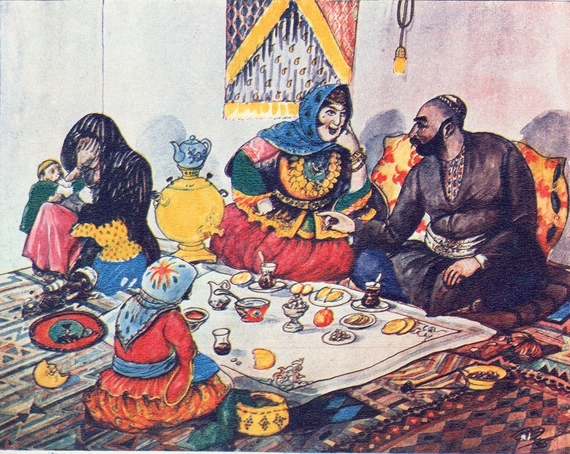The old wife and the new one by Azim Azimzade (1935)
Given all the Kim Davis hoopla, I've been thinking about the phrase "traditional marriage," and wondering how the concept of "traditional" is being applied. Normally the term is related to time and frequency of a practice. If something has been around a long time and repeated over and over again, it becomes a tradition.
And so I decided to look at the Christian "one man, one woman" argument, commonly known as "traditional marriage," from this perspective. And oops! I immediately found that polygany (one man, more than one woman) was alive and well in Christianity until relatively recently:
- In the epistles, St. Paul counseled that church leaders have only one wife, which makes it pretty clear that it wasn't a requirement for regular Christians.
- Augustine and St. Basil of Caesarea both wrote about it in the 4th century. Socrates of Constantinople addressed it in the 5th century.
- Even Reformation hero Martin Luther thought it was permissible under some circumstances, saying: "I confess that I cannot forbid a person to marry several wives, for it does not contradict the Scripture. If a man wishes to marry more than one wife he should be asked whether he is satisfied in his conscience that he may do so in accordance with the word of God. In such a case the civil authority has nothing to do in the matter."
In simultaneous contrast, the Council of Trent took a firm stance on the issue in 1563, finally declaring polygany and concubinage anathema.
So. Let's ignore the polygany that continues to occur in Mormon circles, and call 1563 the Christian beginning of "one man, one woman." That means that what people are calling "traditional marriage" has been the standard for 452 years as of the date of this writing.
Abraham is the first biblical example of polygany, and he walked the earth around 2,000BCE. If I do the math, that means that for at least 3,563 years, marriage between one man and more than one woman was occurring among the faithful.
That's 3,563 years of polygany compared to 452 years of "one man, one woman".
So that's the Christian view. What about outside Christianity?
The Ethnographic Atlas reports that out of 1,231 societies, 186 are monogomous, 453 include occasional polygany, 588 practice more frequent polygany, and 4 permit polyandry. So that means that 1,045 societies permit polygamy compared to 186 which don't.
That's about 85% vs. 15%
So please, "one man, one woman" defenders; in what way is monogamy more traditional?
Easy answer. It isn't.

